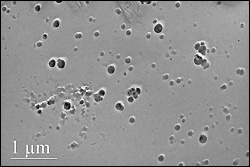News Story
UMD, NIST Expand Alliance
"We have a rich alliance, aided greatly by our close proximity, and also by our common goal of providing scientific leadership, innovation and economic prosperity to the region and the nation."
-Patrick Gallagher, director, NIST.
Patrick Gallagher, undersecretary of commerce and director of the National Institute of Standards and Technology (NIST), visited the university last month to meet with faculty researchers and administrators, previewing his vision for expanding their robust research and educational collaborations.
"We have a rich alliance, aided greatly by our close proximity, and also by our common goal of providing scientific leadership, innovation and economic prosperity to the region and the nation," Gallagher said to the standing room-only crowd.
Gallagher spoke at length about the need for the nation's research community to be the driving force behind innovation. NIST and UMD are already involved with science and outreach efforts designed to help U.S. manufacturers create and retain jobs, increase profits and save time and money through the Maryland Technology Enterprise Institute's Manufacturing Assistance Program (UMMAP). UMMAP, part of NIST's Manufacturing Extension Partnership, is one of more than 70 not-for-profit centers nationwide that provide consulting services to small and medium-sized companies.
He also highlighted the established collaborative programs already in place with the university—including research in neutron scattering, quantum physics and nanotechnology—and previewed new research thrusts at NIST that match well with the university's strengths, including work in biophysics, cybersecurity, cloud computing and health information technology.
"Our scientific community is well-positioned to align ourselves with any new priorities at NIST," says Norma Allewell, UMD's interim vice president for research. "We really couldn't ask for a better opportunity, both for our faculty researchers and for our graduate students."
One successful partnership is a NIST-funded fellowship program that sends 50 fellows per year to work at NIST laboratories in Gaithersburg, Md., and Charleston, S.C., where they can use the latest technologies to study weight and measurement. Funded last year with $15 million in federal stimulus funds, the fellowship program, which is open to all qualified applicants, is administered by the university's Institute for Research in Electronics and Applied Physics (IREAP).
In another collaborative effort, ongoing for almost two decades, faculty, postdocs and students in the A. James Clark School of Engineering's Department of Materials Science and Engineering (MSE) have worked with the NIST Center for Neutron Research. There, groundbreaking research in neutron scattering—a powerful method for characterizing the nanoscale structure of solids, liquids and macromolecules—is advancing science and technology projects crucial for maintaining U.S. leadership in the world economy.
"The opportunity for Maryland scientists and students to use the world-class research facilities at NIST is unparalleled," says MSE professor and chair Robert M. Briber, the principal investigator of several NIST-funded projects involving neutron scattering research.
At the Institute for Bioscience and Biotechnology Research in Shady Grove, Md., the university partners with NIST and others on research involving nanobiotechnology, drug and vaccine discovery and the study of disease processes.
A key component of the alliance between NIST and UMD is the Joint Quantum Institute, or JQI, focused on advancing a basic understanding of the universe, as well as developing technologies for cryptography, advanced computing and the design and use of sensors.
A NIST-funded Laboratory for Advanced Quantum Science, part of the JQI, is set for completion in 2013, part of the university’s new $128 million Physical Sciences Complex now under construction.
Story courtesy of Thomas R. Ventsias, University Communications.
Published May 31, 2011












